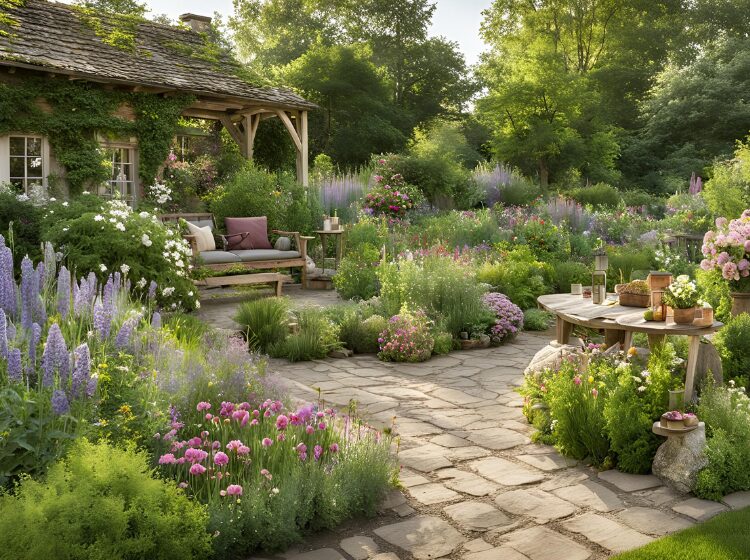Creating a country garden is all about embracing the rustic charm and natural beauty that define the countryside. Whether you have a sprawling backyard or a cozy patch of green, incorporating rustic elements into your garden can evoke a sense of warmth, nostalgia, and timeless appeal. From weathered wood to vintage accents, these country garden ideas will help you transform your outdoor space into a peaceful retreat where nature and tradition come together.
1. Worn Wooden Fences
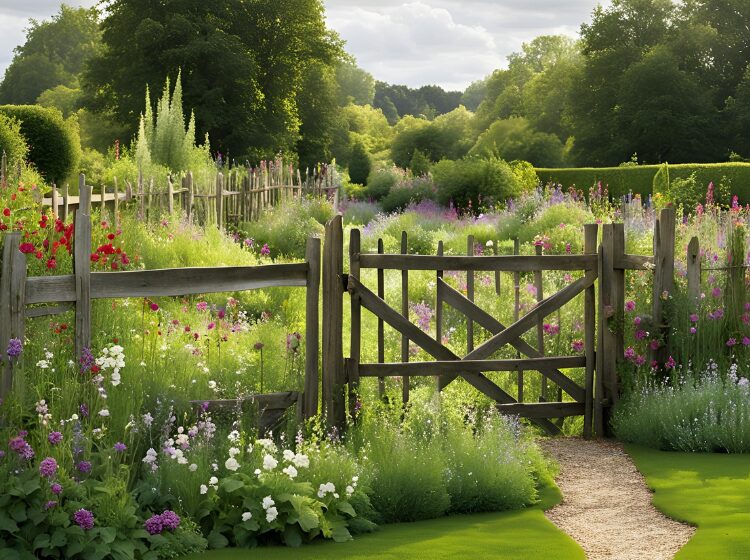
A classic element of any country garden, worn wooden fences add both charm and structure to your outdoor space. The appeal of weathered wood lies in its ability to blend seamlessly with nature, creating a harmonious boundary that feels like it’s always been there.
- Choosing the Right Wood: Opt for durable, weather-resistant wood like cedar or oak. If you’re aiming for an aged look, you can speed up the process by using wood-aging solutions or even simple techniques like vinegar and steel wool treatments.
- Repurposing Old Barn Wood: For a truly authentic rustic vibe, consider sourcing reclaimed wood from barns or other structures. The imperfections and signs of wear will add character to your garden.
- Enhancing the Look: Pair your worn wooden fence with climbing plants such as ivy, roses, or clematis. As they grow, they’ll soften the lines of the fence and create a lush, natural backdrop.
Incorporating worn wooden fences into your garden not only adds a rustic touch but also provides a sense of privacy and security, while still feeling open and inviting.
2. Vintage Metal Garden Décor
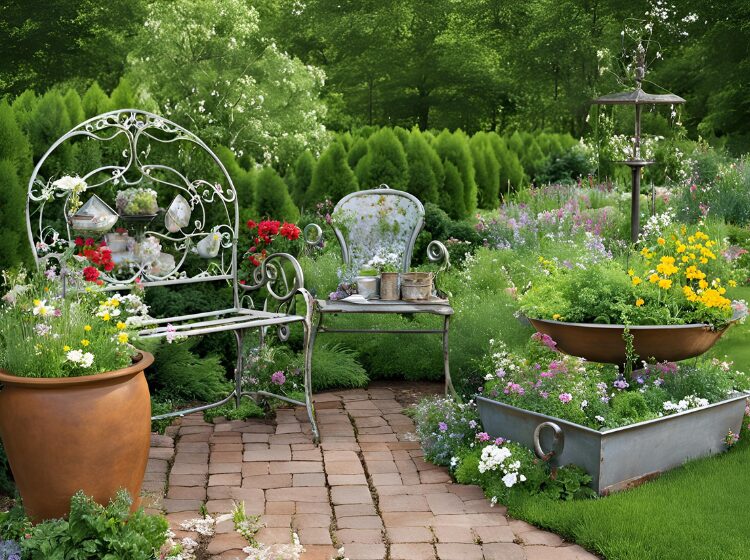
Incorporating vintage metal pieces into your garden is a fantastic way to add rustic charm. These items, often rich with history, can serve as focal points or subtle accents that tie your space together.
- Selecting Vintage Pieces: Look for items like old watering cans, wrought iron gates, metal tubs, or even antique farming tools. Flea markets, antique stores, and online marketplaces are great places to find these treasures.
- Restoring or Distressing Metal: If you find a piece that’s in good condition but lacks that vintage look, you can distress it yourself using sandpaper, paint, or patina solutions. Alternatively, embrace the rust and let the piece age naturally in your garden.
- Placement: Position vintage metal items strategically around your garden. A rusted wheelbarrow can become a planter, while an old iron gate can serve as a backdrop for climbing plants.
The addition of vintage metal decor gives your garden a sense of history and makes it feel like a well-loved, lived-in space.
3. Stone Pathways

Stone pathways are a staple of country gardens, offering both beauty and practicality. They guide visitors through the garden, leading them to different areas while adding texture and visual interest.
- Choosing the Right Stone: Natural stone, such as flagstone, slate, or cobblestone, works best in rustic settings. Look for stones with irregular shapes and rough textures to maintain a natural look.
- Layout: For a truly rustic feel, avoid perfectly straight lines. Let your path meander through the garden, curving gently around flower beds and trees. Consider leaving space between the stones for moss or ground cover plants to grow, adding an aged, organic appearance.
- Maintenance: While stone pathways are durable, they may require occasional maintenance. Keep the stones free of weeds and debris, and replace or reposition any that shift over time.
A stone pathway adds a sense of journey and exploration to your garden, inviting visitors to wander and enjoy the space.
4. Rustic Wooden Pergolas
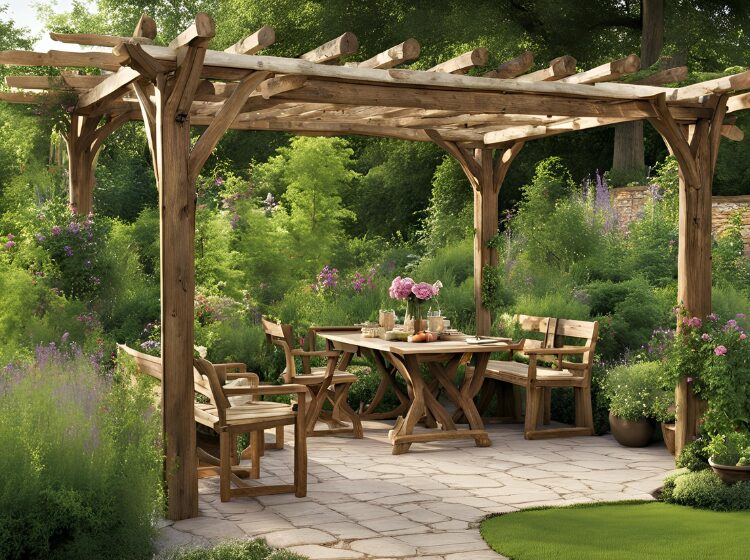
A wooden pergola is a beautiful addition to a country garden, offering both form and function. It adds height and structure to the garden, while also providing a shaded area for relaxation.
- Selecting the Right Timber: For a rustic look, choose rough-hewn timber, such as cedar or reclaimed wood. The natural grain and imperfections in the wood will enhance the country feel.
- Climbing Plants: Pair your pergola with climbing plants like wisteria, jasmine, or grapevines. As they grow and wind around the structure, they’ll create a lush, green canopy that provides shade and privacy.
- Usage: Use your pergola to frame a seating area, creating an outdoor living space that’s perfect for dining or relaxing. Alternatively, position it over a pathway to create a stunning garden entrance.
A rustic pergola serves as both a functional and decorative element in your garden, providing a focal point that draws the eye and invites you to linger.
5. Wildflower Meadows
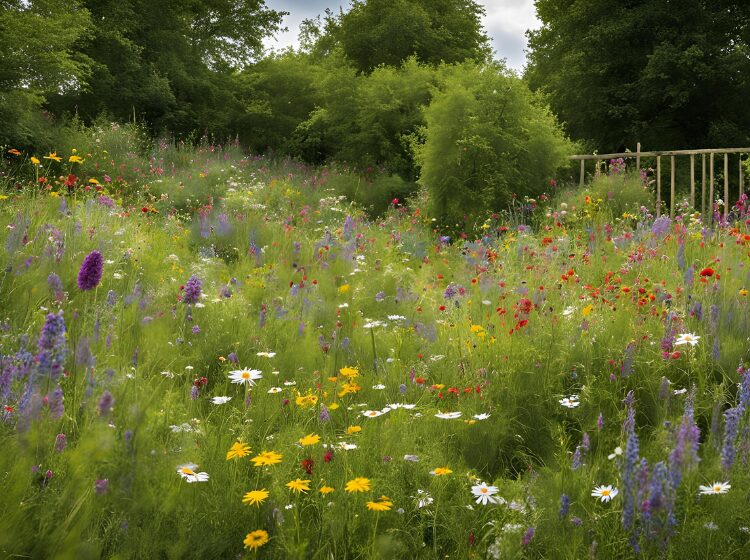
Wildflower meadows are a wonderful way to bring a touch of the countryside into your garden. They’re low-maintenance, eco-friendly, and offer a stunning array of colors and textures throughout the year.
- Choosing Wildflowers: Opt for native wildflowers that thrive in your region. Popular choices include poppies, daisies, cornflowers, and black-eyed Susans. These plants are typically hardy and attract pollinators like bees and butterflies.
- Planting: Scatter wildflower seeds in informal patterns, allowing them to grow freely. Avoid overly structured planting; instead, let nature take its course.
- Maintenance: Once established, wildflower meadows require minimal maintenance. They should be mowed just once or twice a year to encourage new growth and keep the area looking tidy.
A wildflower meadow brings a sense of untamed beauty to your garden, offering a stunning contrast to more manicured spaces.
6. Rustic Potting Bench
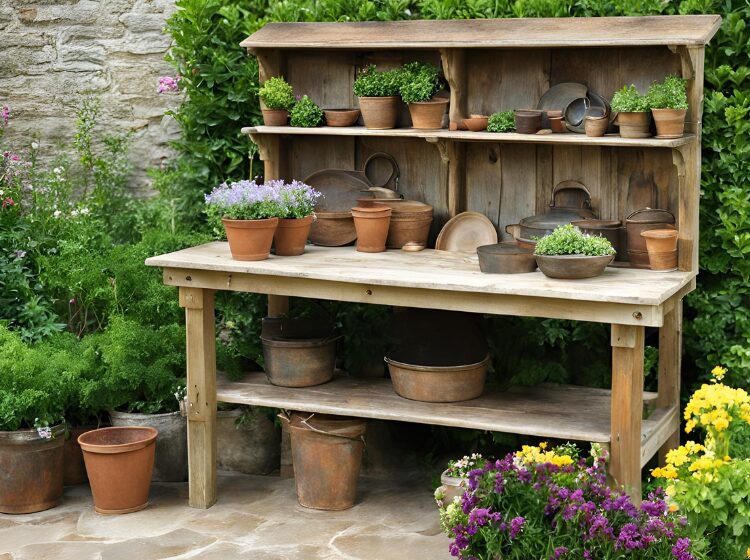
A rustic potting bench is a practical addition to your garden, providing a dedicated space for all your gardening tasks. But beyond its functionality, it can also serve as a charming decorative feature.
- DIY or Purchase: You can either build your own potting bench from reclaimed wood or purchase a pre-made one with a weathered finish. Look for benches with plenty of storage space for pots, tools, and soil.
- Decorative Elements: Use your potting bench to display potted plants, vintage containers, and garden tools. Add hooks for hanging tools or baskets, and consider incorporating a small chalkboard for notes and reminders.
- Placement: Position your potting bench near your vegetable patch or greenhouse for easy access. Alternatively, place it in a prominent spot where it can be enjoyed as a decorative feature.
A rustic potting bench combines functionality with charm, making it a must-have for any country garden.
7. Country Garden Seating Areas
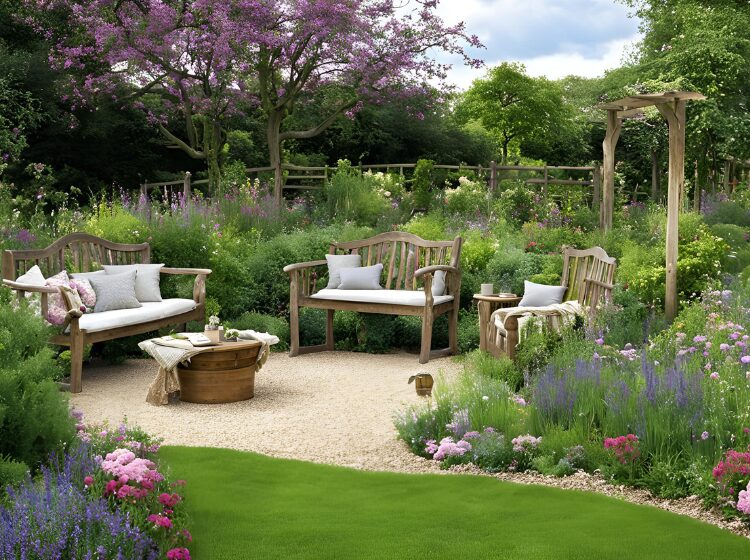
No country garden is complete without a cozy seating area where you can relax and enjoy the beauty of your surroundings. Rustic seating options, such as wooden benches, Adirondack chairs, or wrought iron seats, fit perfectly in a country garden setting.
- Choosing Seating: Look for seating with a distressed or vintage look. Wooden benches with rough-hewn edges, wrought iron chairs with weathered patina, or Adirondack chairs in natural wood tones all work well in a rustic garden.
- Cozy Touches: Add cushions, blankets, and throw pillows in natural fabrics like linen or cotton. These touches not only make the seating more comfortable but also enhance the rustic vibe.
- Placement: Place seating under a tree, beside a flower bed, or in a secluded corner of the garden. This creates a peaceful retreat where you can unwind and enjoy the garden.
Rustic seating areas invite you to slow down, relax, and fully immerse yourself in the beauty of your country garden.
8. Repurposed Farm Tools
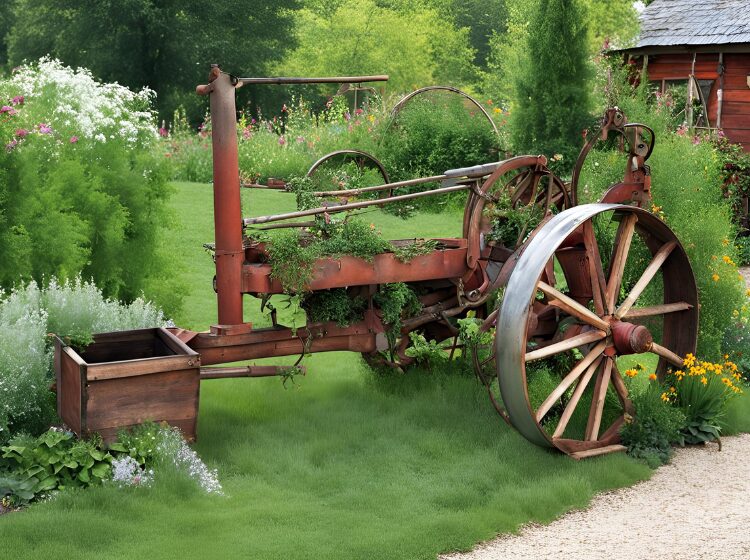
Old farm tools may no longer be functional, but they can still serve as unique and charming garden decor. Repurposing these tools adds a rustic touch to your garden while giving them a new lease on life.
- Choosing Tools: Look for old tools like rakes, spades, plows, or scythes. These items can often be found at flea markets, antique stores, or even in your own shed. The more worn and weathered, the better.
- Preserving or Distressing: Depending on the condition of the tools, you can either preserve them as they are or add a bit of distressing for a more rustic look. A light sanding and a coat of clear varnish can help protect them from further rusting.
- Creative Uses: Hang farm tools on garden walls or fences, use them as plant supports, or even turn them into unique art pieces by arranging them in creative ways.
Repurposed farm tools add a sense of history and authenticity to your garden, making it feel like a true country retreat.
9. Stone Garden Walls
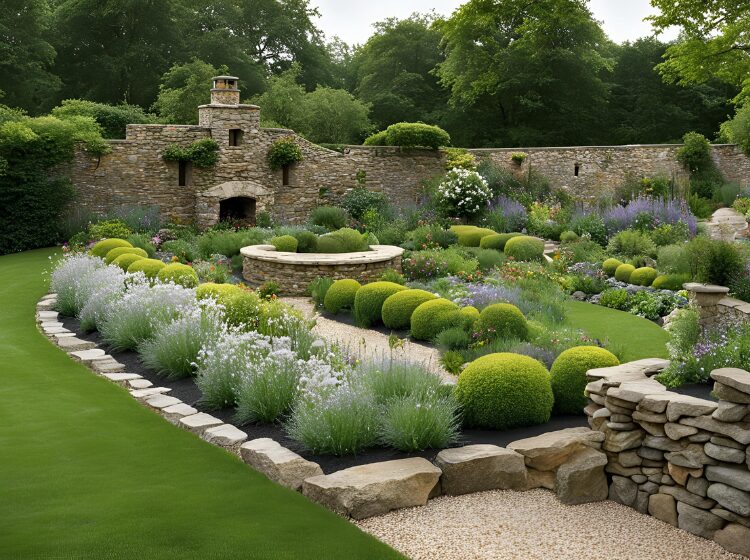
Stone garden walls are another quintessential element of country gardens, providing both structure and a sense of permanence. These walls can define garden spaces, serve as a backdrop for plants, or even act as seating areas.
- Choosing Stones: Opt for rough, irregular stones to create a natural, weathered look. Fieldstone, limestone, or sandstone are great choices for a rustic garden wall.
- Building the Wall: Dry-stacked stone walls, where the stones are laid without mortar, offer a more rustic appearance. Over time, plants like moss, ferns, and creeping vines can grow between the cracks, further enhancing the natural look.
- Incorporation: Use stone walls to define different areas of your garden, such as separating the vegetable patch from the flower beds. They can also serve as a backdrop for climbing plants or as a low seating wall near a seating area.
Stone walls add a timeless beauty to your garden, grounding the space and creating a sense of enclosure.
10. Rustic Garden Arbors
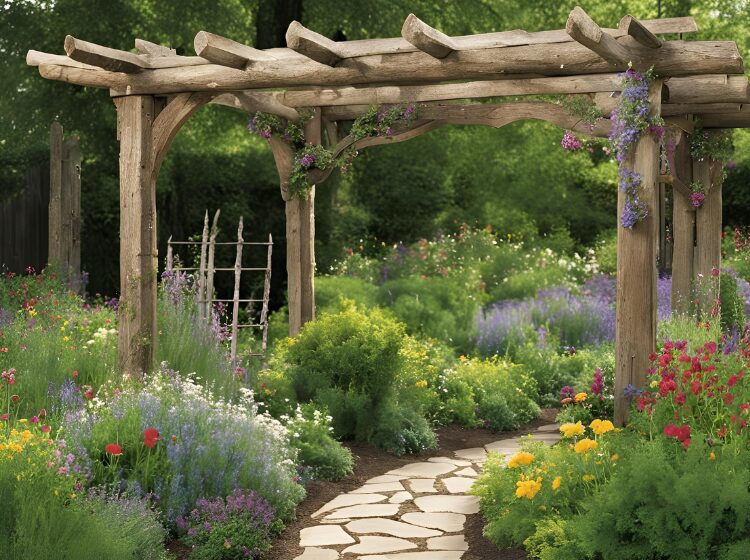
Garden arbors are a lovely addition to any garden, and rustic ones, in particular, add a touch of country charm. These structures can serve as entrances, focal points, or simply a place to grow climbing plants.
- Choosing Materials: For a rustic look, opt for natural wood, such as cedar, or even reclaimed timber. Aged metal arbors with a weathered finish can also create a vintage feel.
- Decorating the Arbor: Allow climbing plants, such as roses, wisteria, or honeysuckle, to grow over the arbor. Over time, the plants will soften the structure and create a beautiful, fragrant canopy.
- Placement: Position your arbor at the entrance to your garden or along a path. It can also frame a seating area or serve as a backdrop for a garden bench.
A rustic garden arbor adds height and interest to your garden, creating a romantic and inviting atmosphere.
11. Wooden Garden Sheds
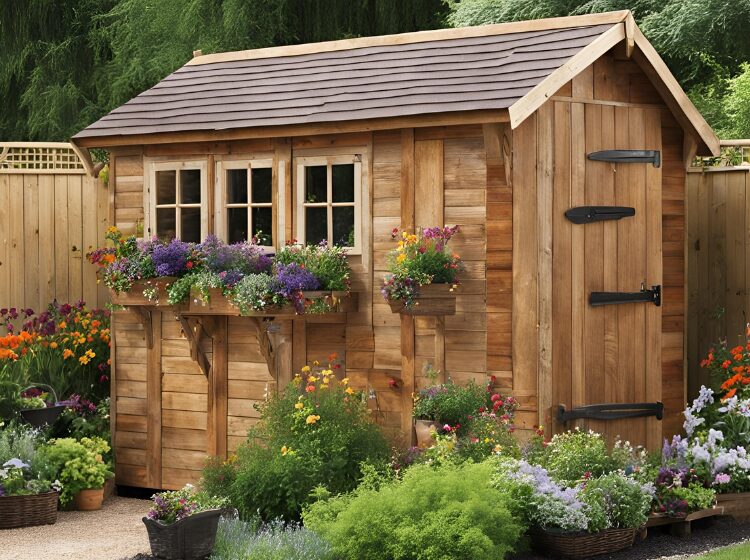
A wooden garden shed is not only practical but also adds rustic charm to your outdoor space. Whether you use it for storage or as a workspace, a shed can be a focal point in your garden.
- Choosing the Right Shed: Look for a shed with a traditional design, such as a gabled roof and wooden siding. Cedar or pine are good choices for a rustic look, and you can enhance the aged appearance with a weathered finish or paint.
- Decorating the Shed: Add window boxes, hanging baskets, or even a small porch to make your shed feel like a part of the garden. You can also use the shed as a backdrop for climbing plants or espaliered fruit trees.
- Functionality: Inside the shed, keep things organized with shelves, hooks, and storage bins. This ensures that your shed remains functional while also serving as a charming garden feature.
A rustic garden shed can be both a practical and aesthetic addition to your garden, offering storage and a touch of countryside charm.
12. Rustic Garden Trellises

Trellises are essential for supporting climbing plants, and rustic versions can also serve as decorative features in your garden. They add height, structure, and a sense of enclosure to your outdoor space.
- DIY or Purchase: You can either build your own trellis from reclaimed wood or purchase a pre-made one with a distressed finish. Look for trellises with simple, sturdy designs that complement the rustic aesthetic.
- Plant Choices: Pair your trellis with climbing plants that suit a country garden, such as roses, clematis, or grapevines. Over time, the plants will cover the trellis, creating a lush, green wall.
- Placement: Position your trellis against a wall, along a fence, or in the middle of a garden bed. You can also use multiple trellises to create a garden room or screen off a section of your garden.
Rustic garden trellises add both beauty and functionality to your garden, helping to create a sense of enclosure and privacy.
13. Cottage-Style Flower Beds

Cottage-style flower beds are the heart of any country garden. These beds are characterized by a mix of colorful flowers, herbs, and even vegetables, all growing together in an informal, abundant style.
- Choosing Plants: Opt for a mix of perennials, annuals, and herbs that thrive in your climate. Popular choices include lavender, hollyhocks, foxgloves, and delphiniums, as well as herbs like rosemary, thyme, and sage.
- Planting Style: Plant in a dense, informal manner, allowing plants to grow and intermingle naturally. Avoid rigid rows or formal borders; instead, let the plants spill over the edges of the beds.
- Maintenance: While cottage-style beds may look wild, they do require some maintenance. Regular deadheading, pruning, and weeding will keep the beds looking their best.
Cottage-style flower beds add a riot of color and texture to your garden, creating a welcoming and joyful atmosphere.
Wrapping Up
Creating a country garden is about more than just adding a few rustic elements; it’s about embracing a lifestyle that values simplicity, natural beauty, and a connection to the land. Whether you’re incorporating worn wooden fences, stone pathways, or wildflower meadows, each of these ideas contributes to the overall charm and tranquility of your outdoor space.
Try combining multiple country garden ideas to create a garden that feels like a true rural retreat—a place where you can relax, unwind, and enjoy the simple pleasures of life in the countryside.

